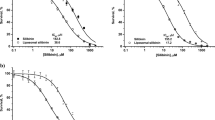Abstract
N-l-leucyl-doxorubicin and vinblastine-isoleucinate can be considered as relatively non-toxic prodrugs from doxorubicin and vinblastine, respectively. A comparative analysis was carried out of the anti-tumour activity of the four compounds as well as vintriptol in four human ovarian cancer xenografts different in histology, growth rate and chemosensitivity. Injections were given i.v. weekly twice into mice bearing well-established s.c. tumours. At equitoxic doses, the amount of drug administered for N-l-leucyl-doxorubicin and vinblastine-isoleucinate was respectively 3-fold and 2-fold higher than the doses of the parent compound. N-l-leucyl-doxorubicin induced a growth inhibition > 50% in three out of four human ovarian cancer lines. The anti-tumour effects obtained were significantly better (P < 0.01) than in the case of doxorubicin. Vinblastine-isoleucinate studied in two of these lines could induce a growth inhibition of > 50%. This prodrug appeared slightly less effective than vinblastine. Insignificant growth inhibition (< 50%) was obtained by vintriptol.
Similar content being viewed by others
Author information
Authors and Affiliations
Rights and permissions
About this article
Cite this article
Boven, E., Hendriks, H., Erkelens, C. et al. The anti-tumour effects of the prodrugs N-l-leucyl-doxorubicin and vinblastine-isoleucinate in human ovarian cancer xenografts. Br J Cancer 66, 1044–1047 (1992). https://doi.org/10.1038/bjc.1992.407
Issue Date:
DOI: https://doi.org/10.1038/bjc.1992.407
- Springer Nature Limited
This article is cited by
-
Monitoring subcellular biotransformation of N-l-leucyldoxorubicin by micellar electrokinetic capillary chromatography coupled to laser-induced fluorescence detection
Analytical and Bioanalytical Chemistry (2014)
-
Molecular imaging of gene therapy for cancer
Gene Therapy (2004)




